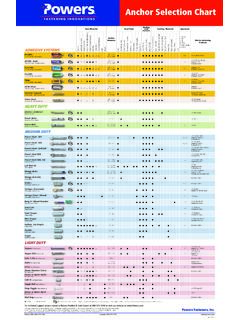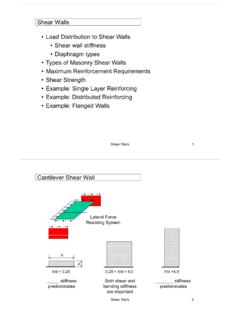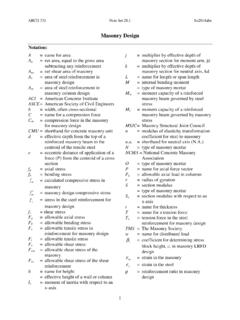Transcription of Types of analysis: Linear static, linear dynamic and non ...
1 Types of analysis: Linear static, Linear dynamic and non Linear static Paulo B. Louren o Safety Assessment of Existing Buildings Institute for Sustainability and Innovation in Structural Engineering 3 | Types of analysis: Linear static, Linear dynamic and non Linear static Paulo B. Louren o Non- Linear static analysis Linear static analysis Simplification Structural Analysis Methods (Static) Institute for Sustainability and Innovation in Structural Engineering 4 | Types of analysis: Linear static, Linear dynamic and non Linear static Paulo B.
2 Louren o Early Structural Analysis Ut tensio sic vis or / E = is the elasticity law established by R. Hooke in theory is so extensively used that its limitations and deficiencies are often forgotten. This is in opposition with early forms of limit analysis. Cantilever beam according to Galileo (1638) and evolution of the hypothesis for the stress distribution at AB Retaining wall according to Coulomb (1773) B A PInstitute for Sustainability and Innovation in Structural Engineering 5 | Types of analysis: Linear static, Linear dynamic and non Linear static Paulo B. Louren o Modern Structural Analysis As structural collapse does not generally coincide with the appearance of the first crack or localized early crushing, it seems that the elasticity theory is a step back with respect to limit analysis Full nonlinear analysis (the most advanced form of structural analysis) covers the complete loading process, from the initial stress-free state, through the weakly nonlinear behavior under service loading, up to the strongly nonlinear behavior leading to collapse Interest has been growing since 1970 s but it remains a field for selected (few)
3 Specialists due to complexity (knowledge) and costs (time) involved The possibilities are immense and several commercial software packages include some form of nonlinear behavior, but an incorrect use can be very dangerous Institute for Sustainability and Innovation in Structural Engineering 6 | Types of analysis: Linear static, Linear dynamic and non Linear static Paulo B. Louren o Modern Structural Analysis The modern use of nonlinear analysis focuses mostly on these three fields: Complex / stringent safety requirement structures ( nuclear plants, dams, bridges) Virtual laboratory for parametric studies Existing structures (evaluation, repair, rehabilitation) Three Types of non-linearities may arise: Material (or physical) nonlinearity FGeometrical nonlinearity Contact nonlinearity Steel ( code model ) Concrete ( code model ) Institute for Sustainability and Innovation in Structural Engineering 7 | Types of analysis.
4 Linear static, Linear dynamic and non Linear static Paulo B. Louren o Existing Buildings Settlements Vertical dead + live load Vehicles Institute for Sustainability and Innovation in Structural Engineering 8 | Types of analysis: Linear static, Linear dynamic and non Linear static Paulo B. Louren o Modern Earthquake Design Macro-models (Braga, Liberatore, D Asdia, Magenes, Lagomarsino, etc.) Storey model (Por) Tomazevic Finite element model (Many authors) Elastic analysis leads to excessively conservative solutions for unreinforced , confined, and possibly, reinforced masonry Institute for Sustainability and Innovation in Structural Engineering 9 | Types of analysis: Linear static, Linear dynamic and non Linear static Paulo B.
5 Louren o Example of Analysis of an Arch The solution: Ut pendet continuum flexile, sic stabit contiguum rigidum inversum as hangs the flexible line, so but inverted will stand the rigid arch. In 1675 Hooke provided the solution for he equilibrium of an arch by means of an anagram included in the book "A description of Helioscopes and some other Instruments", which was only deciphered after his death in 1703. Robert Hooke (1635-1703)- Principle of the inverted catenary Institute for Sustainability and Innovation in Structural Engineering 10 | Types of analysis: Linear static, Linear dynamic and non Linear static Paulo B.
6 Louren o Graphic Statics The arch is first decomposed in a series of real or fictitious voussoirs separated by a series of planes (the planes do not need to be parallel) The thrust line is defined as the geometrical locus of the points of application of the sectional forces (the resulting forces over each plane between voussoirs) across the arch An arch is stable if it is possible to find a thrust line contained between its boundaries Institute for Sustainability and Innovation in Structural Engineering 11 | Types of analysis: Linear static, Linear dynamic and non Linear static Paulo B. Louren o Kinematic Analysis Charles-Agustin COULOMB (1736-1806) proposed in 1773 the first general and accurate theory on the stability of masonry arches The basic assumptions are: (1)Sliding between voussoirs is unlikely due to the existing frictional forces (2)Collapse will be caused by the rotation between parts due to the appearance of a number of hinges.
7 The location of the hinges is a priori unknown but can be determined by the method of maxima and minima Institute for Sustainability and Innovation in Structural Engineering 12 | Types of analysis: Linear static, Linear dynamic and non Linear static Paulo B. Louren o Kinematics of 4-hinge collapse Institute for Sustainability and Innovation in Structural Engineering 13 | Types of analysis: Linear static, Linear dynamic and non Linear static Paulo B. Louren o Correspondence with THRUST LINE theory: a hinge will develop each time the equilibrium line becomes tangent to an alternate boundary. In this condition (failure), the thrust line is determined and unique.
8 Institute for Sustainability and Innovation in Structural Engineering 14 | Types of analysis: Linear static, Linear dynamic and non Linear static Paulo B. Louren o Collapse of an arch brought experimentally to failure Institute for Sustainability and Innovation in Structural Engineering 15 | Types of analysis: Linear static, Linear dynamic and non Linear static Paulo B. Louren o Static Analysis Methods (I) Linear Elastic Analysis elastic properties + maximum admissible stress Kinematic Collapse Mechanism Analysis inelastic properties = friction angle + tensile and compressive strengths Static Thrust Line Analysis Non- Linear Analysis (Physical and Combined) FULL inelastic properties (ft = 0 and ft 0) + elastic properties 5 3 10 kN Institute for Sustainability and Innovation in Structural Engineering 16 | Types of analysis: Linear static, Linear dynamic and non Linear static Paulo B.
9 Louren o Static Analysis Methods (II) Max. N/mm2 Linear Elastic Kin. load factor : Failure Mechanism Geo. load factor : Thrust Line Min. N/mm2 Linear Elastic Min. N/mm2 Phys. Non- Linear Min. N/mm2 Comb. Non- Linear Institute for Sustainability and Innovation in Structural Engineering 17 | Types of analysis: Linear static, Linear dynamic and non Linear static Paulo B. Louren o Static Analysis Methods (III) 0 5 10 15 Vertical displacement at quarter span (mm) Load factor Limit analysis ft = 0, Physically non- Linear ft = 0, Physically / Geometrically non- Linear ft = N/mm2, Physically non- Linear ft = N/mm2, Physically / Geometrically non- Linear Institute for Sustainability and Innovation in Structural Engineering 18 | Types of analysis: Linear static, Linear dynamic and non Linear static Paulo B.
10 Louren o Static Analysis Methods (III) Approach/Analysis type Semi-circular arch Allowable stresses (fta= N/mm2) Kinematic limit analysis Geometric safety factor ft = 0, Physically non- Linear ft = 0, Physically and geometrically non- Linear ft = N/mm2, Physically non- Linear ft = N/mm2, Phys. and geom. non- Linear The safety factors of a Linear elastic analysis and a static limit analysis cannot be compared with the remaining safety factors. Physically non- Linear analysis and kinematic limit analysis yield the same failure mechanisms and safety factors? The consideration of a non-zero, yet low and degrading, tensile strength increased the safety factors considerably.




